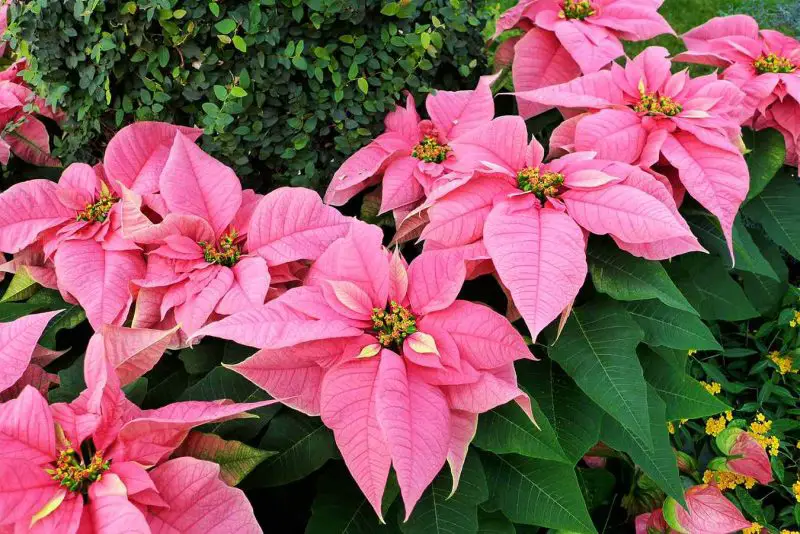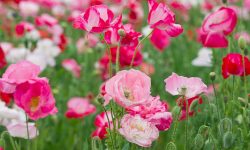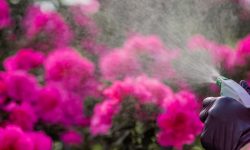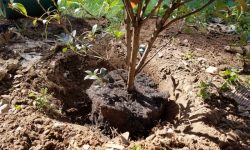Poinsettias are one of the most beloved symbols of the holiday season, instantly brightening homes with their vibrant red, white, or pink bracts. Yet many people wonder: how long do poinsettias last once they’ve been brought indoors or gifted during Christmas? While these festive plants are often treated as temporary decorations, with the right care they can last far beyond the holidays—sometimes for months, or even return to bloom the following year.
The lifespan of a poinsettia depends on several factors, including how it was cared for before purchase, the conditions in your home, and the attention you give it afterward. From proper watering and light exposure to pruning and fertilization, small steps can dramatically extend its beauty. Whether you want your poinsettia to thrive through the winter or rebloom next holiday season, understanding its natural cycle is the first step toward success.
Understanding the Natural Lifespan of Poinsettias

The natural lifespan of a poinsettia is often misunderstood. Many people assume these plants are short-lived, meant only for a few weeks of holiday cheer. In reality, poinsettias are perennials in their native climate of Mexico and Central America. With consistent care, they can live for several years. The holiday blooms may fade, but the plant itself can continue to grow and rebloom, offering beauty far beyond the festive season.
Typically, poinsettias purchased in December last four to six weeks in full color indoors. With proper light, watering, and temperature control, the bracts can remain attractive until March or even April. After the colorful display fades, the plant enters a resting stage. This phase is essential for recovery, allowing the plant to conserve energy before starting new growth in spring. During this time, leaves may drop, which is normal, but the stems remain alive and ready to produce new shoots.
For those who care for poinsettias year-round, the plant can thrive well beyond the holiday season. It requires pruning, fertilization, and careful light management to prepare for reblooming. Some poinsettias have been known to last several years, becoming lush and bushy with repeated cycles of growth and dormancy. Understanding this natural rhythm helps you set realistic expectations and plan effective care routines. Instead of discarding the plant after Christmas, you can enjoy its transformation and look forward to another season of colorful bracts.
Factors That Affect Poinsettia Longevity
Light Conditions
Light is one of the most important factors that determine how long a poinsettia lasts. These plants naturally grow in bright but indirect light, similar to what they would experience beneath taller vegetation in their native environment. Indoors, a sunny window facing east or south often provides the ideal setting. Without enough light, the bracts fade quickly, and the plant loses its vibrant holiday appeal. Prolonged darkness or dim conditions also weakens the stems, making the plant leggy and unattractive.
On the other hand, too much direct sunlight can also harm poinsettias. Strong rays may scorch the leaves, leading to brown spots or premature wilting. To strike the right balance, it’s best to place them where they receive several hours of bright filtered light each day. Rotating the pot occasionally ensures all sides of the plant receive equal exposure, preventing uneven growth. When light conditions are properly managed, the lifespan of the poinsettia extends naturally, and the plant stays attractive much longer.
Temperature and Humidity
Temperature and humidity strongly influence how long poinsettias remain vibrant. These plants prefer moderate indoor conditions, ideally between 65 and 75 degrees Fahrenheit during the day. Night temperatures slightly cooler, around 60 degrees, are beneficial for extending bloom life. Exposure to sudden drafts, whether from open windows, doors, or heating vents, stresses the plant and often causes leaves to yellow and fall prematurely. Consistent indoor climate is therefore essential to maximize longevity.
Humidity is equally important because dry indoor air during winter can be harsh on poinsettias. Low humidity often leads to curled leaves, faster fading, and an overall weakened plant. To counteract this, placing a humidity tray under the pot or using a room humidifier helps maintain balance. Mist spraying lightly can also refresh the foliage, though it should be done with care to avoid soggy soil. By maintaining stable temperature and humidity, poinsettias hold their color longer and continue to thrive well beyond the festive season.
Watering Practices
Watering is one of the most common factors that determine how long poinsettias last. These plants are sensitive to both underwatering and overwatering, and mistakes can shorten their lifespan. If the soil dries out completely, the leaves droop, and the bracts fade more quickly. On the other hand, soil that stays constantly soggy can lead to root rot, which is often fatal. Finding the right balance is essential for keeping the plant vibrant.
A good approach is to water thoroughly when the top inch of soil feels dry, then allow excess water to drain away. Poinsettias should never sit in standing water, so removing any water collected in the saucer is crucial. During the blooming season, the plant typically requires more frequent watering due to higher indoor heat. After flowering, water needs decrease slightly, but consistency is still key. Proper watering not only prevents stress but also supports healthy foliage and longer-lasting blooms.
Fertilization and Soil Quality
Fertilization and soil quality play a direct role in how long poinsettias remain healthy. While blooming, these plants usually do not need heavy feeding, as too much fertilizer can reduce the intensity of their bract color. However, once the blooming period ends, the plant benefits from balanced nutrients to recover strength and prepare for new growth. A general-purpose houseplant fertilizer applied every two to three weeks is often enough to maintain vigor. Without proper feeding, the poinsettia may grow weak stems and pale leaves, reducing its lifespan.
Soil quality also determines how well the roots function. Poinsettias thrive in well-draining soil that holds moisture without becoming waterlogged. Heavy, compacted soil suffocates roots, while overly sandy mixes dry out too quickly. A high-quality potting mix with organic matter creates the right environment for sustained growth. Repotting the plant every one to two years can refresh the soil and prevent compaction. With both balanced fertilization and healthy soil, poinsettias can remain robust, supporting long-lasting foliage and preparing for another cycle of colorful bracts.
Extending Poinsettia Beauty Beyond the Holidays
Many people discard poinsettias once the holiday season ends, but with proper care, the plant can remain attractive well into spring. The key lies in maintaining consistent light, water, and temperature conditions even after the bracts begin to fade. By treating the poinsettia as a living plant rather than a temporary decoration, you give it the chance to thrive. Leaves may fall, but this is part of its natural cycle, not a sign of failure.
To extend vibrancy, continue watering when the soil feels slightly dry and provide bright, indirect light. Regularly removing faded leaves helps the plant redirect its energy toward healthy growth. If bracts begin to drop, focus on nurturing the remaining foliage. Pruning lightly after the flowering season encourages fresh shoots. Many gardeners find that poinsettias can stay lush and green for months after Christmas if cared for properly.
Fertilization also supports longevity. Once blooming ends, begin feeding the plant with a balanced houseplant fertilizer every two to three weeks. This helps strengthen stems and replenish nutrients used during flowering. By late spring, the poinsettia may enter a resting phase, but it can bounce back with renewed growth when the seasons change. With dedication, your poinsettia can outlast its reputation as a short-lived holiday plant, becoming a vibrant part of your home for much longer.
Seasonal Care for Poinsettias
Winter Care
Winter is the season when poinsettias are at their peak beauty, showcasing vibrant bracts that brighten homes during the holidays. To maintain this beauty, provide bright but indirect light, as direct sun through a cold window can damage the foliage. Keep the plant in a stable environment, ideally between 65 and 70 degrees Fahrenheit, avoiding cold drafts from doors and windows. Consistent conditions help prevent leaf drop, which is a common issue during this time. Poinsettias are sensitive to sudden temperature changes, so even a short exposure to cold air can shorten their display.
Watering should be carefully monitored in winter because the indoor heating system often dries out the air. Check the soil regularly and water only when the top inch feels dry, ensuring good drainage to avoid root rot. Removing decorative foil around the pot helps excess water escape and keeps roots healthy. Fertilization is usually not necessary while the plant is blooming, but occasional misting can provide extra humidity. By keeping light, temperature, and water balanced, poinsettias can stay colorful for many weeks, often lasting well into late winter before transitioning to their resting phase.
Spring Care
Spring marks the transition period for poinsettias as their colorful bracts begin to fade and the plant shifts toward rest. During this time, many leaves may yellow and drop, which is a natural part of the cycle. Reduce watering slightly compared to winter, but never allow the soil to become bone dry. Bright, indirect light remains important for keeping the plant healthy, as it supports the development of new green growth. Keeping the plant away from drafts and maintaining temperatures around 60 to 70 degrees Fahrenheit ensures stability during this adjustment phase.
Pruning in spring is essential to encourage compact and bushy growth. Cut the stems back to about six inches from the soil, which stimulates fresh shoots. Once new growth appears, begin fertilizing every two to three weeks with a balanced houseplant fertilizer to replenish nutrients. This is also the best time to repot the plant if the soil has become compacted or the container is too small. With attentive spring care, the poinsettia builds strong roots and prepares for lush summer growth.
Summer Care
Summer is the season when poinsettias focus on vigorous vegetative growth, producing lush green foliage that prepares the plant for later flowering. At this stage, it is highly beneficial to move the plant outdoors once nighttime temperatures consistently stay above 60 degrees Fahrenheit. Choose a location with bright, indirect light or partial shade, since too much direct sun can scorch the delicate leaves. Outdoor placement allows poinsettias to enjoy natural air circulation, which helps strengthen stems and reduces the chance of fungal issues. Regular watering is essential in summer, as the soil dries quickly in warm weather, but drainage must remain excellent to prevent root rot.
Fertilization is a key part of summer care. Feed the plant every two weeks with a balanced fertilizer to support strong development and rich green foliage. Pinching back the tips of new stems every few weeks encourages branching, which creates a bushier plant with more potential flowering sites later in the year. It is also wise to rotate the pot regularly so all sides receive equal light, ensuring even growth. Watch for pests such as aphids, whiteflies, and spider mites, which are more common outdoors. With consistent summer attention, poinsettias build the resilience and shape needed for a beautiful holiday display.
Fall Care
Fall marks the most critical transition period for poinsettias, as the plant shifts from leafy growth toward preparing for its colorful holiday display. In early fall, bring the plant back indoors before night temperatures dip below 55 degrees Fahrenheit. Place it in a bright location with indirect sunlight for at least six hours a day. Reduce fertilization gradually to signal the plant that the growing season is slowing down, while maintaining moderate watering so the soil stays slightly moist but never soggy. Consistency during this stage is vital, since sudden changes in temperature or moisture can trigger leaf drop.
The most important aspect of fall care is initiating the darkness treatment to encourage bract coloration. Starting around late September or early October, provide 14 to 16 hours of complete darkness each night for about 8 to 10 weeks, while still giving bright light during the day. This can be achieved by placing the plant in a closet or covering it with a light-proof box each evening. Any disruption in the dark cycle can delay or prevent the bracts from turning red. By carefully managing light exposure and indoor conditions, you ensure that the poinsettia will produce the vibrant holiday colors it is cherished for.
Common Problems That Shorten Poinsettia Lifespan
Overwatering and Root Rot
Overwatering is one of the most frequent problems that shortens the life of poinsettias. These plants have delicate root systems that quickly suffer if the soil remains saturated for too long. Excess water displaces air pockets in the soil, depriving the roots of oxygen and creating ideal conditions for fungal diseases. Root rot sets in rapidly, causing lower leaves to yellow, wilt, and eventually fall. Many poinsettias that appear to “suddenly die” are actually victims of prolonged waterlogging.
To prevent this, always ensure the pot has drainage holes and never leave the plant sitting in a saucer of water. It is better to underwater slightly than to overwater, as poinsettias are more resilient to short dry periods. Using a well-draining potting mix with added perlite or sand can further reduce the risk of root rot. If root rot is suspected, trimming away affected roots and repotting into fresh soil may save the plant. Careful watering habits are therefore essential to extending poinsettia lifespan and keeping its foliage bright and healthy.
Temperature Stress and Drafts
Poinsettias are highly sensitive to fluctuations in temperature, which can significantly shorten their lifespan. Exposure to cold drafts from doors, windows, or air conditioners often causes leaves to curl, yellow, and drop prematurely. Similarly, sudden blasts of hot, dry air from heaters or fireplaces can stress the plant, leading to wilted foliage and reduced bract color. Even brief exposure to temperatures below 50 degrees Fahrenheit during transport from the store to home can damage poinsettias irreversibly. This is why they are often considered delicate despite their popularity.
To protect poinsettias from temperature stress, maintain a consistent indoor environment between 65 and 75 degrees Fahrenheit. Keep them away from exterior doors, drafty hallways, or heating vents where temperature swings are most extreme. Using curtains to buffer against cold windows or placing the plant in a more central location of the home can help stabilize its environment. For extra care, avoid moving the plant too frequently, as sudden changes in light and temperature can compound stress. By shielding poinsettias from drafts and extremes, you create a stable environment that allows them to thrive much longer indoors.
Pests and Disease Issues
Poinsettias are susceptible to several pests and diseases that can drastically reduce their lifespan. Common pests include whiteflies, spider mites, and aphids, which feed on the leaves and stems, causing discoloration, leaf drop, and stunted growth. Infestations often go unnoticed until significant damage has occurred. Fungal and bacterial diseases, such as botrytis or root rot, also threaten the plant, especially when combined with overwatering or poor air circulation. Early detection is crucial to prevent permanent damage.
To manage these problems, inspect the plant regularly for signs of pests or unusual spots on leaves. Wipe down leaves with a damp cloth or use insecticidal soap for minor infestations. Ensure proper air circulation and avoid overcrowding plants to reduce disease risk. Treat fungal infections with appropriate fungicides if detected early. Maintaining healthy growing conditions, such as balanced watering, consistent temperatures, and adequate light, helps strengthen the plant’s natural defenses. With attentive care, pests and diseases can be managed effectively, allowing the poinsettia to maintain its vibrant foliage and extend its overall lifespan.
Encouraging Rebloom for the Next Season
Many gardeners dream of seeing their poinsettias bloom again for the next holiday season. Encouraging rebloom requires patience and a clear understanding of the plant’s natural cycle. After the bracts fade, the plant enters a resting phase, during which growth slows and some leaves may drop. This period is essential for the plant to conserve energy for new shoots and flowers. Accepting this dormancy is the first step toward a successful rebloom.
To promote new growth, begin pruning the plant in late winter or early spring. Cut stems back to about six inches above the soil, removing old or weak branches. Fertilize regularly with a balanced, water-soluble fertilizer every two to three weeks to replenish nutrients and stimulate healthy shoots. Keep the plant in bright, indirect light and maintain consistent indoor temperatures, avoiding drafts and sudden temperature changes. Proper care during this stage ensures a robust framework for the next set of bracts.
As summer approaches, continue to nurture the poinsettia with adequate watering and occasional pinching to encourage compact, bushy growth. By late September or early October, begin controlling light exposure to initiate bract coloration. Provide 14 to 16 hours of complete darkness nightly for 8 to 10 weeks, while giving bright light during the day. Following this strict schedule allows the plant to produce vibrant red, pink, or white bracts in time for the next holiday season. With patience and attention, your poinsettia can bloom beautifully year after year.
Display Tips to Maximize Bract Longevity
Proper display is key to prolonging the vibrant bracts of poinsettias. Position the plant in a bright spot with plenty of indirect light. Direct sunlight can scorch the delicate bracts, causing premature fading or browning at the edges. Rotating the pot every few days ensures even light exposure, which prevents uneven growth and maintains a uniform appearance. Keeping the plant away from drafty windows and doors protects it from sudden temperature fluctuations that can trigger leaf drop.
Another important factor is temperature and airflow. Poinsettias thrive in temperatures between 65 and 75 degrees Fahrenheit, with slightly cooler nights around 60 degrees. Avoid placing the plant near heaters, fireplaces, or cold air vents, as these extremes stress the foliage. Using a stable indoor environment helps the bracts retain their color longer and reduces the risk of wilting. Additionally, maintaining a moderate level of humidity around the plant, either by occasional misting or a nearby humidifier, keeps the leaves supple and prevents premature drying.
Watering and pot selection also affect display longevity. Ensure the pot has proper drainage and never let water accumulate at the bottom, which can cause root rot and leaf drop. Remove decorative foil temporarily to allow excess water to escape. Minimal handling of the plant is advised, as frequent movement or bumping can damage bracts. By combining thoughtful placement, consistent temperature, careful watering, and gentle handling, you can maximize the lifespan of poinsettias, keeping them looking lush and festive throughout the holiday season and even beyond.
Transporting and Gifting Poinsettias Safely
Poinsettias are delicate plants, and improper handling during transport or gifting can significantly shorten their lifespan. When moving the plant, it is essential to maintain a stable temperature. Avoid exposing the plant to extreme cold, such as leaving it in a car overnight or near drafty doors. Similarly, protect it from direct sunlight or heat sources during transport, as sudden temperature changes can stress the foliage and bracts, causing leaf drop or fading.
When gifting poinsettias, wrapping them carefully is crucial. Use lightweight paper or a breathable sleeve to protect the leaves and bracts from damage. Avoid plastic that traps heat or moisture, which can promote fungal growth. Secure the pot to prevent tipping during transport, and remind the recipient to remove wrapping immediately upon arrival. A few simple precautions during handling ensure that the plant arrives in pristine condition and can maintain its vibrant display longer.
After gifting, immediate care is essential to extend the plant’s life. Place the poinsettia in a bright location with indirect sunlight, maintain consistent indoor temperatures, and monitor soil moisture closely. Water only when the top inch of soil is dry and ensure proper drainage. Encouraging the recipient to follow these steps helps the poinsettia recover from transit stress and continue thriving. Thoughtful transport, careful gifting, and immediate post-arrival care collectively support long-lasting beauty and healthy growth.
FAQ About How Long Poinsettias Last
How long do poinsettias typically last indoors?
Poinsettias usually last four to six weeks in full color indoors. With proper care, including consistent light, moderate watering, and stable temperatures, the bracts can remain vibrant for up to two months. After the holiday season, leaves may drop, but the plant itself can live for several years with ongoing care.
Can poinsettias rebloom next year?
Yes, poinsettias can rebloom if cared for correctly. After the bracts fade, prune the plant, provide balanced fertilizer, and maintain bright, indirect light. In early fall, implement a strict light and dark cycle to trigger bract coloration. Following these steps allows the plant to produce vibrant bracts again the next holiday season.
Why are my poinsettia leaves turning yellow?
Yellowing leaves are often caused by overwatering, poor drainage, or sudden temperature changes. Ensure the soil is well-draining, water only when the top inch is dry, and maintain consistent indoor temperatures. Avoid placing the plant near drafts or heat sources, which can stress it and lead to leaf discoloration.
How should I water my poinsettia correctly?
Water thoroughly when the top inch of soil feels dry, allowing excess to drain freely. Never let the plant sit in standing water. During the blooming season, check soil moisture frequently, and reduce watering slightly after the bracts fade. Proper watering prevents root rot and maintains healthy foliage and bract color.
Can poinsettias survive outdoors?
Poinsettias are tropical plants and cannot tolerate freezing temperatures. They can survive outdoors only in warm climates where temperatures stay above 55 degrees Fahrenheit. In cooler regions, keep them indoors or in a greenhouse. Adequate light, humidity, and protection from wind and frost are essential for outdoor survival.
Conclusion
Poinsettias are more than seasonal decorations; with proper care, they can thrive for months and even rebloom year after year. Consistent watering, bright indirect light, stable temperatures, and attention to pests and soil health all contribute to extended vibrancy. By understanding their natural cycle and providing seasonal care, you can enjoy lush foliage and radiant bracts well beyond the holidays. Thoughtful display, careful handling, and ongoing maintenance transform poinsettias into long-lasting indoor treasures. With dedication, these festive plants can bring beauty, color, and joy to your home season after season.






